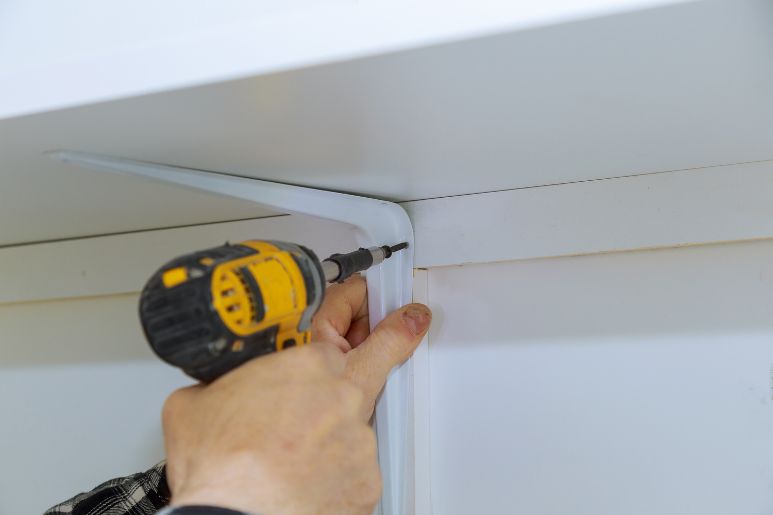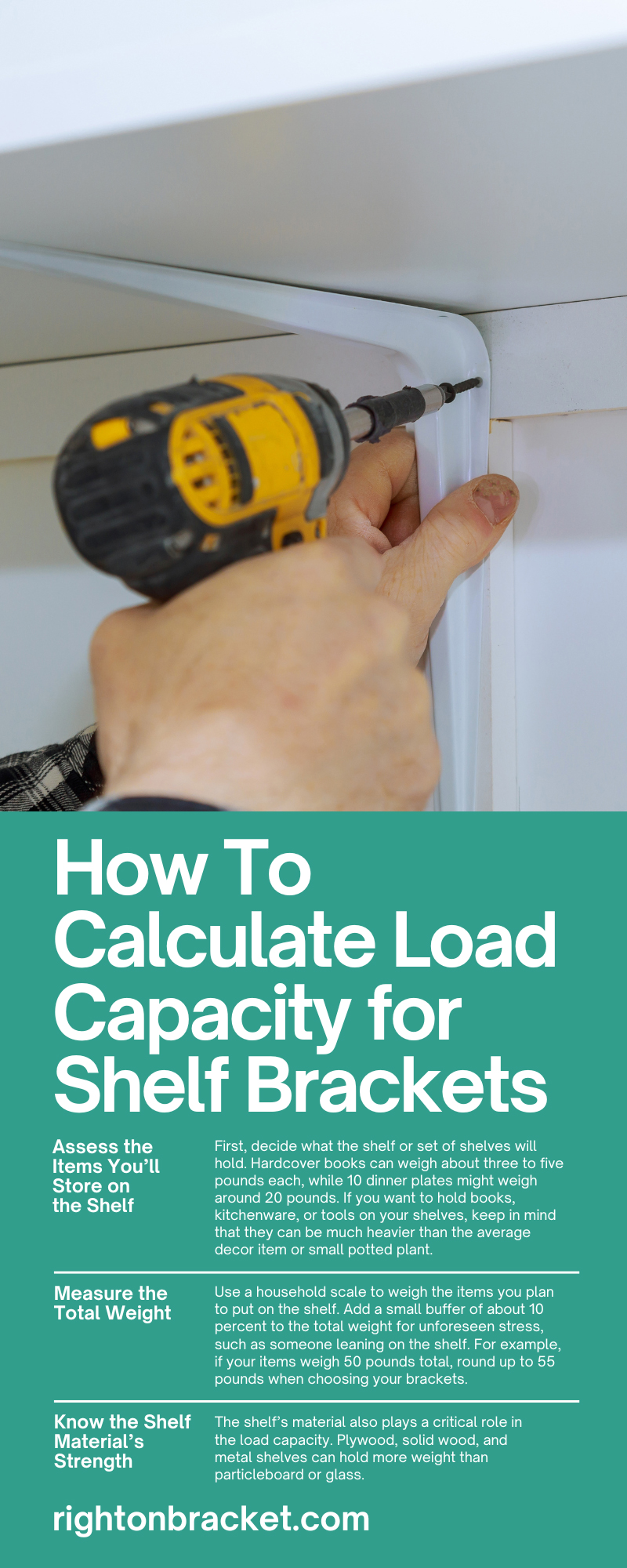
How To Calculate Load Capacity for Shelf Brackets
Taking on a home improvement project can be an empowering experience, allowing homeowners to showcase their craftiness and creativity while boosting their home’s functionality and aesthetic appeal. Installing shelves is a common DIY task for anyone looking to organize their home’s interior. With upgraded shelving, homeowners can maximize storage, declutter their environment, and showcase their personal collections or decorative items.
However, the success of your shelving project depends on the load capacity of the shelf brackets you use. A miscalculation can lead to sagging shelves, damaged walls, or even personal injury. Explore everything you need to know about how to calculate load capacity for shelf brackets, so you can complete your project confidently and accurately.
Why Calculating Load Capacity Is Important
Picture this—you’ve installed a beautiful wooden shelf, only to watch it tilt forward or collapse because it couldn’t hold the weight of your books, plants, or tools. Calculating the right load capacity is essential to ensure that both the shelf and its brackets can bear the total load safely over time. Overloading the brackets can jeopardize your belongings, damage the wall, or present a safety hazard to you and your housemates.
By taking the time to calculate the proper load capacity, you can set your project up for durability, safety, and success.
Key Terms You Should Know
Before you buy any materials, take a moment to understand some key terms related to shelf brackets and load-bearing strength.
Load Capacity
A bracket’s load capacity refers to the maximum weight it can support without falling or breaking. It depends on factors like the material of the brackets, the wall type you mount them to, and the installation method you use.
Weight Distribution
Weight distribution ensures that the load you place on top of the shelf rests evenly along the length of the shelf and the brackets. Uneven weight distribution can cause the shelf to droop or fall, even if the overall weight is within the brackets’ capacity.
Bracket Types
Many bracket types exist, and each one is designed for specific purposes and with its own load-bearing limits. Standard types include floating brackets, heavy-duty brackets, and L-brackets.
If you want minimalist shelf brackets for a sleek look, floating brackets are the solution. Floating shelf brackets don’t show in the completed project, as they can hide behind and inside the shelf, allowing you to achieve your desired aesthetic. Source the brackets you want from a reliable manufacturer such as Right On Bracket. Our handmade bracket designs are sturdy, with high weight capabilities that can last a long time and support nearly any shelving project.
Step-By-Step Instructions for Calculating Load Capacity
As you roll up your sleeves and begin calculating the load capacity required for your brackets, be sure to complete the following steps:
Assess the Items You’ll Store on the Shelf
First, decide what the shelf or set of shelves will hold. Hardcover books can weigh about three to five pounds each, while 10 dinner plates might weigh around 20 pounds. If you want to hold books, kitchenware, or tools on your shelves, keep in mind that they can be much heavier than the average decor item or small potted plant.
Measure the Total Weight
Use a household scale to weigh the items you plan to put on the shelf. Add a small buffer of about 10 percent to the total weight for unforeseen stress, such as someone leaning on the shelf. For example, if your items weigh 50 pounds total, round up to 55 pounds when choosing your brackets.
Know the Shelf Material’s Strength
The shelf’s material also plays a critical role in the load capacity. Plywood, solid wood, and metal shelves can hold more weight than particleboard or glass.
Choose the Number of Brackets
In general, the more brackets you use, the more weight the shelf can carry. Two brackets for a short shelf are common, but longer shelves often require three or more brackets.
Use the Manufacturer’s Load Ratings
Each bracket type will have a manufacturer-specified weight limit, such as “supports up to 75 lbs.” Match this rating to the total weight you calculated earlier. Ensure the load rating applies to your wall type as well. Drywall, for example, may hold less weight without additional support than concrete or wood studs.
Check the Weight Distribution
Finally, confirm that the weight distribution will be even along the shelf’s length. Don’t heavily cluster items on one end unless you’re going to add an additional bracket or support.
Tips for Choosing the Right Shelf Brackets
With so many bracket types available, choosing the right one might feel overwhelming. Here’s a quick guide that can help make your decision easier.
Material Matters
Steel and iron brackets offer the highest load capacities and are perfect for heavy-duty use. Aluminum brackets are lightweight but have lower weight limits. Consider using brackets made of plastic or resin only for light loads on small decorative shelves.
Consider the Wall Type
Use appropriately rated anchors or toggle bolts if you’re dealing with drywall. For concrete or brick walls, you’ll need concrete screws and anchors. Wood studs offer the most secure foundation for heavy brackets.
Think About Shelf Dimensions
Thicker wood or metal shelves can usually bear more weight without sagging. Confirm that the shelf’s length won’t cause stress on the brackets, as more extended shelves often require additional support.
Common Mistakes To Avoid
Save time and frustration, and keep your home improvement project fun by avoiding these common mistakes:
Overlooking Wall Studs
If you’re working with drywall, always locate and mount at least one bracket into a wall stud. Failing to do so can result in weak support that gives out over time.
Ignoring Bracket Ratings
Resist the urge to repurpose old or low-quality brackets for heavy-duty shelves. Instead, choose brackets with load ratings that exceed your total calculated weight.
Uneven Installation
Make sure the brackets are level before mounting the shelf. Even a slight incline can shift weight distribution and weaken the shelf over time.
Skipping Pre-Installation Tests
Test the shelf’s stability before placing items on it. Push your hand down on it gently to check if it holds up securely. Listen for any creaks or groans that might indicate strain.
Carefully and Correctly Calculate Your Shelf Load Capacity Today
Calculating the load capacity for shelf brackets is one of the most critical aspects of any home improvement project involving shelving. With accurate calculations, careful planning, and attention to detail, you can ensure that your shelves are functional and create a lasting improvement in your space. Whether you’re displaying family photos, organizing a cluttered garage, or showcasing plants, your well-calculated brackets will provide the foundation you need.



